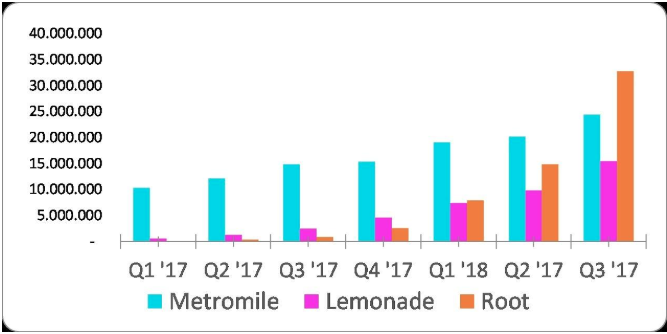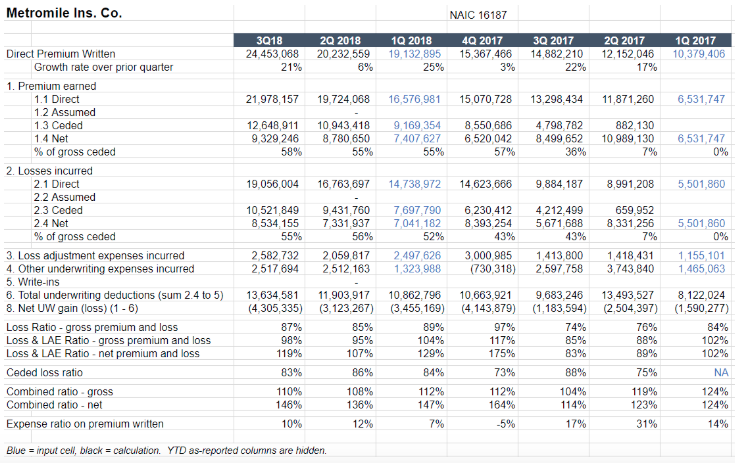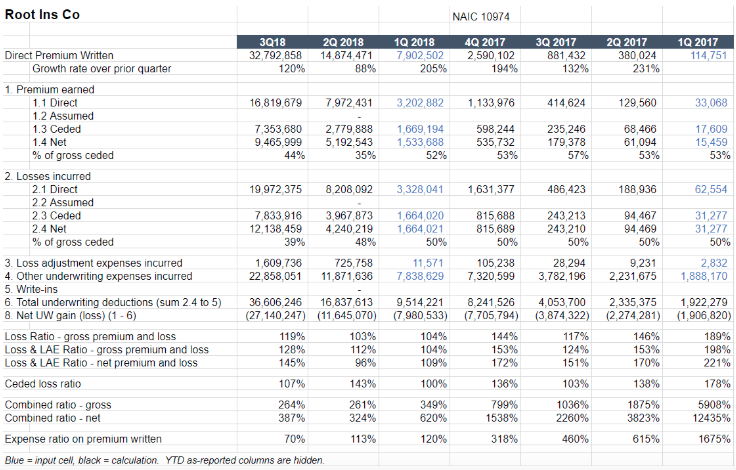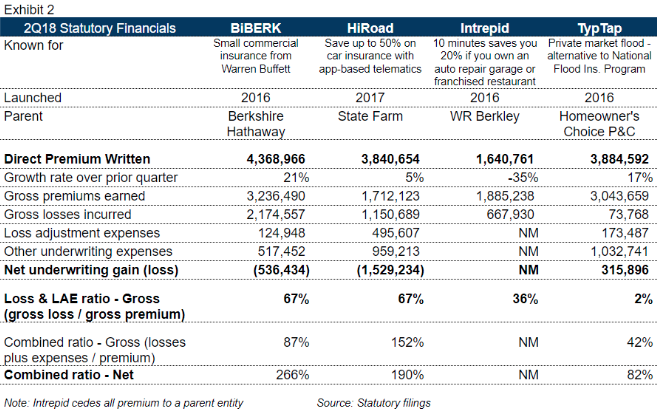Easiest Way to Resolve Claim Disputes
How can you dramatically improve your litigation success? Easy…don’t litigate. Resolve the coverage issue before a claim arises.

How can you dramatically improve your litigation success? Easy…don’t litigate. Resolve the coverage issue before a claim arises.

Get Involved
Our authors are what set Insurance Thought Leadership apart.
|
Partner with us
We’d love to talk to you about how we can improve your marketing ROI.
|

William C. Wilson, Jr., CPCU, ARM, AIM, AAM is the founder of Insurance Commentary.com. He retired in December 2016 from the Independent Insurance Agents & Brokers of America, where he served as associate vice president of education and research.
While there may be comfort in filing documents the traditional way, embracing change and automation will bring relief and clarity.

Get Involved
Our authors are what set Insurance Thought Leadership apart.
|
Partner with us
We’d love to talk to you about how we can improve your marketing ROI.
|

Jesse Wood is the CEO of document management software vendor, eFileCabinet.
There was improvement at insurtechs in the third quarter, but not enough to prove viable business models.

Our three U.S. venture-backed nsurtech carriers have mo' money, mo premiums' and mo' losses. Around the time their losses became notorious, there were some signs of improvement, but not enough to prove viable business models. It’s still early. No 2Pacalypse is imminent, as the startups have tons of cash. But forget about East Coast/West Coast feuds: It’s still insurtechs against the world.
Context This is the fourth installment of our review of U.S. insurtech startup financials. Here are the 2017 edition, the first quarter 2018 edition, which generated many social media discussions, and the second quarter 2018 edition. For more information on where our data come from and important disclaimers and limitations, see the 2017 edition. As we have said since the start, we think all three companies have solid management teams who will figure out a solid business, but it will take time.  1. Premium and losses grow at venture-backed startups As we have said before, it’s early days. Growth is rapid. But all three startup carriers are a long way from profitability and need to continue to raise prices substantially (and thus potentially churn customers), tighten underwriting (which could also materially affect growth) or improve operational aspects that drive losses such as claims performance. In insurance, product-market fit is only demonstrated when selling a product that makes money. Here is the summary of the 3Q18 details of the three venture-backed U.S. insurers that we’ve been tracking. The fourth venture-backed insurer, Next Insurance, did not write premium in 3Q18.
1. Premium and losses grow at venture-backed startups As we have said before, it’s early days. Growth is rapid. But all three startup carriers are a long way from profitability and need to continue to raise prices substantially (and thus potentially churn customers), tighten underwriting (which could also materially affect growth) or improve operational aspects that drive losses such as claims performance. In insurance, product-market fit is only demonstrated when selling a product that makes money. Here is the summary of the 3Q18 details of the three venture-backed U.S. insurers that we’ve been tracking. The fourth venture-backed insurer, Next Insurance, did not write premium in 3Q18.  On expenses, it is important to note that Lemonade received permission from New York State to hide some expenses in an affiliated entity effective at the start of this year, so Lemonade’s expenses aren’t comparable to the others. (Lemonade’s CEO told us that the State of New York requested the change.) Root has followed suit and will now start to hide expenses in an affiliated agency, effective Oct. 1, 2018. Unfortunately, with less transparency, it is harder to verify whether the overall business model actually adds up. Lemonade, for example, makes a big deal about the power of an insurer built on a “digital substrate.” We’re inclined to agree, and we hope they’re right, but we won’t know from their statutory results whether a better expense ratio is really possible. *** The third quarter’s “most improved” award goes to Lemonade, which grew premium by 57% over the prior quarter to $15.5 milliion (perhaps helped by seasonal effects in the rental market) AND turned in a 96% gross & LAE loss ratio, its best ever. The company's reserves developed slightly adversely in the quarter, with YTD unfavorable development standing at $254,000, modestly worse from $245,000 the prior quarter.
On expenses, it is important to note that Lemonade received permission from New York State to hide some expenses in an affiliated entity effective at the start of this year, so Lemonade’s expenses aren’t comparable to the others. (Lemonade’s CEO told us that the State of New York requested the change.) Root has followed suit and will now start to hide expenses in an affiliated agency, effective Oct. 1, 2018. Unfortunately, with less transparency, it is harder to verify whether the overall business model actually adds up. Lemonade, for example, makes a big deal about the power of an insurer built on a “digital substrate.” We’re inclined to agree, and we hope they’re right, but we won’t know from their statutory results whether a better expense ratio is really possible. *** The third quarter’s “most improved” award goes to Lemonade, which grew premium by 57% over the prior quarter to $15.5 milliion (perhaps helped by seasonal effects in the rental market) AND turned in a 96% gross & LAE loss ratio, its best ever. The company's reserves developed slightly adversely in the quarter, with YTD unfavorable development standing at $254,000, modestly worse from $245,000 the prior quarter.  Lemonade has a ways to go -- its reinsurers continue to subsidize the loss ratio (but now paying "only" $2.44 of losses per dollar of premium), the average net loss & LAE ratio is still well above the 40% at which charities receive a giveback, and the company is far from profitability. But re-underwriting and higher rates -- which we discussed in our last post -- may be paying off. There are other explanations, too -- shifting to cat-exposed risk, for example, lowers the loss ratio but raises the cost of capital. See also: Insurtech: Revolution, Evolution or Hype? The company has written $33 million in the first nine months of 2018, which is well behind some exponential expectations published last year. Management also says that they will take out 60 loss ratio points: "A similar progression in the year ahead will get us to where we need to be." Good luck. (Despite the good quarter.) Taking out loss ratio points gets harder for every point you get closer to the industry average. The breeziness of management's comments makes us wonder how much focus will be placed on the hard spadework of loss ratio improvement vs. embarking on a glamorous European Grand Tour. Respected industry analyst V.J. Dowling, whose IBNR Weekly publication (subscription only) was cited in a Lemonade transparency blog supposedly praising Lemonade, recently published a tear-down of Lemonade's strategy. IBNR called the giveback “a joke,” the company's marketing "overly simplistic, constantly changing and borderline dishonest" and “B.S. On Lemonade’s 'Transparency' & Model." We have long taken issue with Lemonade’s definition of “transparency,” which (as with many startups) is transparent only insofar as the company wishes to tell a story, which is just another form of marketing. (We are working on a longer article about ways startups bend numbers and welcome your ideas). We also agree with IBNR that a giveback at 1.6% of premium seems cynical. Middle-class insurance agents are some of the biggest charitable donors and sponsors in many towns, and it’s hard to see the social benefit in Lemonade’s spending the advertising budget enriching amoral tech bros at GAFA rather than sponsoring the town's Little League uniforms as an agent might do. Even insurance veterans don’t seem to realize that all of Lemonade’s entities are for-profit. Don't be fooled: B-Corps are still for-profit corporations. And railing against gun violence is easy, but social consciousness is messy in reality. Metromile grew at a steady and respectable 21% from the prior quarter to $24.5 million of gross premium but ran a 98% gross loss & LAE ratio (not improved from 2017). Among the three players, it has been the ant: slower growth and rather steady results. After seven years in business, the company is barely generating an underwriting profit and is showing little improvement. The company has been taking rate, but not as much as the actuaries say is needed. The company’s latest California indication, for example, is rates up 38%, but the company only took 15 points of rate, effective July 1, 2018, which will work through its book over the next couple of months. Matteo recently published a discussion of why its PAYD (the pay-as-you-drive) approach confirms its niche nature.
Lemonade has a ways to go -- its reinsurers continue to subsidize the loss ratio (but now paying "only" $2.44 of losses per dollar of premium), the average net loss & LAE ratio is still well above the 40% at which charities receive a giveback, and the company is far from profitability. But re-underwriting and higher rates -- which we discussed in our last post -- may be paying off. There are other explanations, too -- shifting to cat-exposed risk, for example, lowers the loss ratio but raises the cost of capital. See also: Insurtech: Revolution, Evolution or Hype? The company has written $33 million in the first nine months of 2018, which is well behind some exponential expectations published last year. Management also says that they will take out 60 loss ratio points: "A similar progression in the year ahead will get us to where we need to be." Good luck. (Despite the good quarter.) Taking out loss ratio points gets harder for every point you get closer to the industry average. The breeziness of management's comments makes us wonder how much focus will be placed on the hard spadework of loss ratio improvement vs. embarking on a glamorous European Grand Tour. Respected industry analyst V.J. Dowling, whose IBNR Weekly publication (subscription only) was cited in a Lemonade transparency blog supposedly praising Lemonade, recently published a tear-down of Lemonade's strategy. IBNR called the giveback “a joke,” the company's marketing "overly simplistic, constantly changing and borderline dishonest" and “B.S. On Lemonade’s 'Transparency' & Model." We have long taken issue with Lemonade’s definition of “transparency,” which (as with many startups) is transparent only insofar as the company wishes to tell a story, which is just another form of marketing. (We are working on a longer article about ways startups bend numbers and welcome your ideas). We also agree with IBNR that a giveback at 1.6% of premium seems cynical. Middle-class insurance agents are some of the biggest charitable donors and sponsors in many towns, and it’s hard to see the social benefit in Lemonade’s spending the advertising budget enriching amoral tech bros at GAFA rather than sponsoring the town's Little League uniforms as an agent might do. Even insurance veterans don’t seem to realize that all of Lemonade’s entities are for-profit. Don't be fooled: B-Corps are still for-profit corporations. And railing against gun violence is easy, but social consciousness is messy in reality. Metromile grew at a steady and respectable 21% from the prior quarter to $24.5 million of gross premium but ran a 98% gross loss & LAE ratio (not improved from 2017). Among the three players, it has been the ant: slower growth and rather steady results. After seven years in business, the company is barely generating an underwriting profit and is showing little improvement. The company has been taking rate, but not as much as the actuaries say is needed. The company’s latest California indication, for example, is rates up 38%, but the company only took 15 points of rate, effective July 1, 2018, which will work through its book over the next couple of months. Matteo recently published a discussion of why its PAYD (the pay-as-you-drive) approach confirms its niche nature.  If Metromile is an ant, Root is a grasshopper. Root again grew extremely rapidly through its TBYB (Try-Before-You-Buy) mobile approach, as one probably would expect of a company with a $1 billion valuation (as we discussed in our previous article). Root doubled the volumes underwritten by Lemonade. But Root continues to struggle with rookie mistakes that drove losses -- discussed more below. Root grew premium by 120% vs. the prior quarter to $33 million for the third quarter but turned in 128% gross loss & LAE ratio - its worst of the year and the worst of the three U.S. insurtech carriers.
If Metromile is an ant, Root is a grasshopper. Root again grew extremely rapidly through its TBYB (Try-Before-You-Buy) mobile approach, as one probably would expect of a company with a $1 billion valuation (as we discussed in our previous article). Root doubled the volumes underwritten by Lemonade. But Root continues to struggle with rookie mistakes that drove losses -- discussed more below. Root grew premium by 120% vs. the prior quarter to $33 million for the third quarter but turned in 128% gross loss & LAE ratio - its worst of the year and the worst of the three U.S. insurtech carriers.  ** With the three carriers resuming rapid growth after a slow 2Q, the 2Q slowdown that we observed in our prior article may have been seasonal or a one-time coincidental slowdown. 2. Industry-backed startups stay focused on underwriting We first pointed out in the prior quarter’s analysis that companies run/led by well-known underwriters were growing slowly but were far more profitable than those with venture capital backing. That hasn’t changed. Here are the four subsidiaries of big companies that are selling direct or have a claim on being an insurtech. These companies often depend on parents for reinsurance and infrastructure, so we show mainly the gross figures.
** With the three carriers resuming rapid growth after a slow 2Q, the 2Q slowdown that we observed in our prior article may have been seasonal or a one-time coincidental slowdown. 2. Industry-backed startups stay focused on underwriting We first pointed out in the prior quarter’s analysis that companies run/led by well-known underwriters were growing slowly but were far more profitable than those with venture capital backing. That hasn’t changed. Here are the four subsidiaries of big companies that are selling direct or have a claim on being an insurtech. These companies often depend on parents for reinsurance and infrastructure, so we show mainly the gross figures.  3. Gross or net - which matters? One well-regarded venture capitalist challenged us on why gross premiums and loss ratio matter when net is what actually sticks to current investors. The difference between gross and net is reinsured premium and loss. The gross loss ratio is provides an unbiased view of the profitability of the book of business, while the net loss ratio may benefit from savvy reinsurance buying, as in the case of Lemonade. See also: How Insurtech Helps Build Trust What matters most is for startups probably the higher of the two loss ratios. If reinsurance reduces the loss ratio, this is only sustainable over time if reinsurers make an adequate return. Reinsurers, like all businesses, tend to demand higher prices when customers lose them money, which in time makes the net loss ratio look more like the gross. In the case of the two auto startups, they are paying reinsurers to take away their biggest losses, so this “cost of reinsurance” needs to be reflected, and the net numbers matter more. 4. Correcting rookie mistakes, experimenting and still underpricing? At the Nov. 30 plenary session of the U.S. IoT Insurance Observatory, Denese Ross of DRC Consulting shared an in-depth 50-page review of Root’s filings, which total over 130,000 pages. Our opinions, based on her factual/non-opinion analysis, is that Root is experimenting aggressively, correcting some rookie mistakes and still underpricing some business.
3. Gross or net - which matters? One well-regarded venture capitalist challenged us on why gross premiums and loss ratio matter when net is what actually sticks to current investors. The difference between gross and net is reinsured premium and loss. The gross loss ratio is provides an unbiased view of the profitability of the book of business, while the net loss ratio may benefit from savvy reinsurance buying, as in the case of Lemonade. See also: How Insurtech Helps Build Trust What matters most is for startups probably the higher of the two loss ratios. If reinsurance reduces the loss ratio, this is only sustainable over time if reinsurers make an adequate return. Reinsurers, like all businesses, tend to demand higher prices when customers lose them money, which in time makes the net loss ratio look more like the gross. In the case of the two auto startups, they are paying reinsurers to take away their biggest losses, so this “cost of reinsurance” needs to be reflected, and the net numbers matter more. 4. Correcting rookie mistakes, experimenting and still underpricing? At the Nov. 30 plenary session of the U.S. IoT Insurance Observatory, Denese Ross of DRC Consulting shared an in-depth 50-page review of Root’s filings, which total over 130,000 pages. Our opinions, based on her factual/non-opinion analysis, is that Root is experimenting aggressively, correcting some rookie mistakes and still underpricing some business.
The following is Matteo & Adrian's interpretation and analysis:
It will take time for the corrections Root has made to show through in results. And particularly on pricing, they may be too little. Thus, the question remains: Is Root’s growth simply the result of selling something far too cheaply, or is it quietly experimenting its way to becoming the next Progressive? 5. Can a startup compete with Progressive and Geico? The most common refrain of startups is that insurance is broken, and their solution will fix it. Oui, c'est vrai. But two companies have their act together more than almost any other insurers: Geico and Progressive, the #2 and #3 auto insurers in the U.S. Geico is famous for its lean expenses, while Progressive runs a loss ratio about six points below the industry average of 69%. It wasn’t always this way. Back in 1996, Progressive was #7, and Geico was #9. There are few other examples in insurance of companies so steadily and regularly gaining market share across decades. In our first article, we showed how startups historically have only won where incumbents leave the door open. Progressive and Geico are not leaving the door open, at least in personal auto as a stand-alone line. Progressive, in particular, has been quite experimental throughout its life, pioneering telematics in the U.S. and experimenting with various ways of paying for auto insurance and using telematics, as some startups are now doing, but with none of Progressive’s advantages. So why do startups try to compete with such well-run companies? We think there are several beliefs (or hopes):
See also: Insurtech’s Act 2: About to Start
This analysis isn’t to suggest that it’s impossible for a startup to win in auto insurance, but that the moat around Geico and Progressive in personal auto is wide and deep. Conclusion The annual figures that are published in March contain a wealth of additional information. To be notified when these numbers are available, please follow the authors on LinkedIn.
Get Involved
Our authors are what set Insurance Thought Leadership apart.
|
Partner with us
We’d love to talk to you about how we can improve your marketing ROI.
|

Matteo Carbone is founder and director of the Connected Insurance Observatory and a global insurtech thought leader. He is an author and public speaker who is internationally recognized as an insurance industry strategist with a specialization in innovation.
Insurers' favorite customers are those who haven’t had any claims for years -- hardly a recipe for building a service culture.

Get Involved
Our authors are what set Insurance Thought Leadership apart.
|
Partner with us
We’d love to talk to you about how we can improve your marketing ROI.
|

Hasan Meral is the head of product and process management at Unico Insurance. He has a BA in actuarial science, an MA in insurance and a PhD in banking.
The transition for a private company going through an IPO can bring unwelcome surprises, including with its D&O insurance.

Get Involved
Our authors are what set Insurance Thought Leadership apart.
|
Partner with us
We’d love to talk to you about how we can improve your marketing ROI.
|

Chris Rafferty is the chief operating officer of Aon’s financial services group (FSG). He is responsible for serving some of Aon’s largest FSG clients, as well as operational strategy, collaboration and best practices across FSG’s specialties and adjacent financial lines.
While proposals are well-automated, and so is policy administration, between the two comes group onboarding. It's a mess.

Get Involved
Our authors are what set Insurance Thought Leadership apart.
|
Partner with us
We’d love to talk to you about how we can improve your marketing ROI.
|

Jeffrey M. Weaver, FLMI, is director of underwriting and actuarial services at Global IQX, a provider of software to group benefits insurers.
Will the future of driverless cars fulfill its grand promise -- or rhyme with the history of the Segway?

Will the future of driverless cars rhyme with the history of the Segway? The Segway personal transporter was also predicted to revolutionize transportation. Steve Jobs gushed that cities would be redesigned around the device. John Doerr said it would be bigger than the internet. The Segway worked technically but never lived up to its backers’ outsized hopes for market impact. Instead, the Segway was relegated to narrow market niches, like ferrying security guards, warehouse workers and sightseeing tours.
One could well imagine such a fate for driverless cars (a.k.a. AVs, for autonomous vehicles). The technology could work brilliantly and yet get relegated to narrow market niches, like predefined shuttle routes and slow-moving delivery drones. Some narrow applications, like interstate highway portions of long-haul trucking, could be extremely valuable but nowhere near the atmospheric potential imagined by many—include me, as I described, for example, in “Google’s Driverless Car Is Worth Trillions.” For AVs to revolutionize transportation, they must reach a high level of industrialization and adoption. They must enable, as a first step, robust, relatively inexpensive Uber-like services in urban and suburban areas. (The industry is coalescing around calling these types of services “transportation as a service,” or TaaS.) In the longer term, AVs must be robust enough to allow for personal ownership and challenge the pervasiveness of personally owned, human-driven cars. See also: Where Are Driverless Cars Taking Industry? This disruptive potential (and therefore enormous value) is motivating hundreds of companies around the world, including some of the biggest and wealthiest, such as Alphabet, Apple, General Motors, Ford, Toyota and SoftBank, to invest many billions of dollars into developing AVs. The work is progressing, with some companies (and regulators) believing that their AVs are “good enough” for pilot testing of commercial AV TaaS services with real customers on public roads in multiple markets, including Singapore, Phoenix and Quangzhou. Will AVs turn out to be revolutionary? What factors might cause them to go the way of the Segway—and derail the hopes (and enormous investments) of those chasing after the bigger prize? Getting AVs to work well enough is, of course, a non-negotiable prerequisite for future success. It is absolutely necessary but far from sufficient. In this three-part series, I look beyond the questions of technical feasibility to explore other significant hurdles to the industrialization of AVs. These hurdles fall into four categories: scaling, trust, market viability and secondary effects. Scaling. Building and proving an AV is a big first step. Scaling it into a fleet-based TaaS business operation is an even bigger step. Here are seven giant hurdles to industrialization related to scaling:
Get Involved
Our authors are what set Insurance Thought Leadership apart.
|
Partner with us
We’d love to talk to you about how we can improve your marketing ROI.
|

Chunka Mui is the co-author of the best-selling Unleashing the Killer App: Digital Strategies for Market Dominance, which in 2005 the Wall Street Journal named one of the five best books on business and the Internet. He also cowrote Billion Dollar Lessons: What You Can Learn from the Most Inexcusable Business Failures of the Last 25 Years and A Brief History of a Perfect Future: Inventing the World We Can Proudly Leave Our Kids by 2050.
A hair-raising drive from Kathmandu to the Nepalese town of Hetuada provides the lessons of entrepreneurship in microcosm.

Get Involved
Our authors are what set Insurance Thought Leadership apart.
|
Partner with us
We’d love to talk to you about how we can improve your marketing ROI.
|

Bobbie Shrivastav is founder and managing principal of Solvrays.
Previously, she was co-founder and CEO of Docsmore, where she introduced an interactive, workflow-driven document management solution to optimize operations. She then co-founded Benekiva, where, as COO, she spearheaded initiatives to improve efficiency and customer engagement in life insurance.
She co-hosts the Insurance Sync podcast with Laurel Jordan, where they explore industry trends and innovations. She is co-author of the book series "Momentum: Makers and Builders" with Renu Ann Joseph.

Eighty years after Karen Blixen published her memoir, "Out of Africa," it may be time for the local insurance industry to start writing a sequel: "Into Africa."
That thought is prompted by a seminar that Africa Re hosted last week in Lagos, Nigeria, and that was put on by our chief innovation officer, Guy Fraker, and by our friend Grace Vandecruze, a veteran investment banker who is now the managing director of Grace Global Capital. Several dozen executives attended from the biggest insurers in Nigeria and Ghana, underscoring the interest in innovation among companies operating on a continent with almost unimaginable opportunity.
Grace said South Africa is the only country on the continent with any significant penetration by insurance products, and just 17% of households there own at least one insurance policy. In every other African country, she said, market penetration ranges from a fraction of a percent to a mere 4% of households. Meanwhile, the continent is home to more than 1.2 billion people and has six of the 10 fastest-growing economies in the world.
Virtually everyone on the continent has a cellphone, so, while companies in the U.S. and Europe complain about having to adapt legacy distribution and customer service networks to the demands of digital customers, insurers in Africa can develop optimized, fully digital systems from the get-go. African countries may also be able to leapfrog more-developed economies and build telecommunications systems based on the next generation of wireless technology, which is known as 5G and which promises Wi-Fi-like capabilities everywhere (though the jury is still out on the actual capabilities of 5G).
When I covered the computer industry for the Wall Street Journal in the '80s and '90s, a common geek joke was:
Q: "How did God manage to create the world in only six days?"
A: "He didn't have an installed base."
Ba-dum-bum.
But the punchline applies here: Because Africa doesn't have an installed based in insurance or in many of the underlying technologies that are being deployed by the industry in other parts of the world, insurers there have a chance to do things right the first time and leapfrog the rest of the globe.
I'm not suggesting that hundreds of business development types from outside the continent immediately book flights to Lagos and other African business centers. There is considerable expertise already there among the major insurers, sometimes facilitated by our new friends at Africa Re.
Insurance still needs to establish a trust factor among consumers in Africa, but the good news, Guy says, is that the low penetration of insurance means that companies have a unique opportunity to work together as a community for now, rather than as competitors. Basically, you have to have a pie before you start fighting over how to divvy it up.
So, let's all do all we can to help bake that pie. As we all know, broadly available insurance will provide stability that the people in Africa and their economies can build on.
Have a great week.
Paul Carroll
Editor in Chief
Get Involved
Our authors are what set Insurance Thought Leadership apart.
|
Partner with us
We’d love to talk to you about how we can improve your marketing ROI.
|

Paul Carroll is the editor-in-chief of Insurance Thought Leadership.
He is also co-author of A Brief History of a Perfect Future: Inventing the Future We Can Proudly Leave Our Kids by 2050 and Billion Dollar Lessons: What You Can Learn From the Most Inexcusable Business Failures of the Last 25 Years and the author of a best-seller on IBM, published in 1993.
Carroll spent 17 years at the Wall Street Journal as an editor and reporter; he was nominated twice for the Pulitzer Prize. He later was a finalist for a National Magazine Award.
The insurance industry has largely resisted, but companies that aren’t racing to innovate will soon be left behind.

Get Involved
Our authors are what set Insurance Thought Leadership apart.
|
Partner with us
We’d love to talk to you about how we can improve your marketing ROI.
|

Haywood Marsh is general manager of NetClaim, which offers customizable insurance claims reporting and distribution management solutions. He leverages experience in operations, marketing, strategic planning, product management and sales to drive the execution of NetClaim’s strategy.